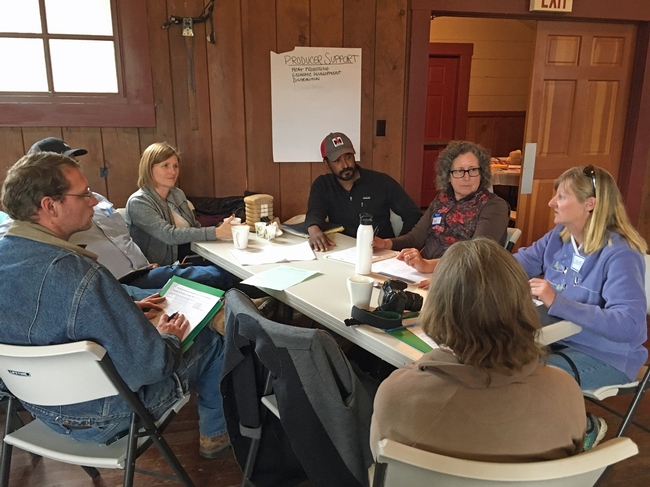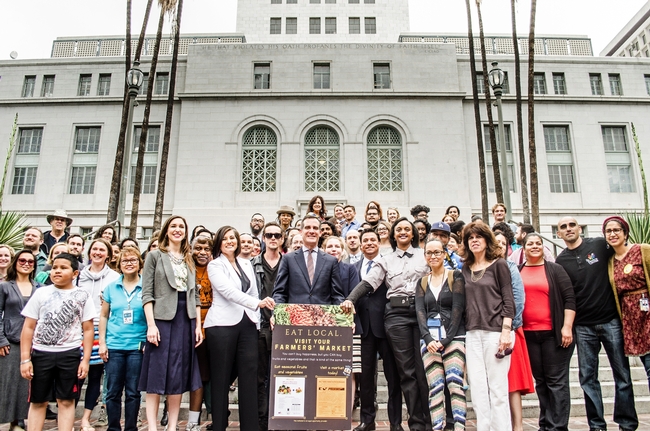In a growing number of communities, food policy councils (also called “food system alliances”) have emerged to address gaps in local policies that focus on food. Most communities have transportation, housing or land use policies, but food policies are frequently missing. Food policy councils (FPCs) are an important way to bring community members together with local government to promote the social, economic and environmental health of local and regional food systems.
Food policy councils are made up of representatives from many sectors in the food system, including farmers, distributors, retailers, food service operations, government agencies (like public health, county social services and county agriculture departments), and community organizations that work in the food system. Some FPCs also develop close partnerships with county-based UC Cooperative Extension to help facilitate their work.
FPCs support a variety of food and agriculture-related policies and programs, including healthy food access, land use planning, regional food procurement, food waste, food and economic development, local food processing, and regulations related to urban farming or community gardening, to name a few examples.
A brief history of food policy councils
FPCs emerged in the late 1980s as the sustainable agriculture and food/nutrition movements began to pay more attention to community food systems. Early FPCs were created through resolutions of local government bodies (Clancy et al 2008). At that time, they tended to be embedded within government, much like a planning commission or a social service commission. As the local food movement began to rapidly expand in the 2000s, many local activists and organizations began to create FPCs as a way to bring together a more diverse group of food system stakeholders. These newer generation FPCs were typically organized outside of government as a non-profit organization or community coalition. Studies of FPCs, including our own, find that they take very diverse organizational forms and tackle widely varying issues, which means that generalizations about their goals and outcomes are difficult to make. This may be quite appropriate however, given the enduring FPC goal of tailoring food policies to the specific characteristics of particular places.
A UC ANR research project is looking at how FPCs work
While FPCs are increasingly on the radar of those trying to promote food system change, we still don't have much recent documented evidence about the actual work of FPCs (though see Harper et al. 2009, Fox 2010 and Borron 2003). In response, a team of UC Cooperative Extension researchers (Clare Gupta, Julia Van Soelen Kim, Dave Campbell, Jennifer Sowerwine, Gail Feenstra, Shosha Capps and Kate Munden-Dixon) began a comparative study of 10 California food policy councils in 2016. We wanted to know this: what are the networks and relationships that FPCs are a part of? And how do these networks and relationships influence what a FPC is able to achieve? As UCCE researchers ourselves, we were especially interested in understanding the nature of relationships between FPCs and university researchers, including UC Cooperative Extension.
To answer these questions, we interviewed more than 60 FPC members from food policy councils across California. We asked them about the work they were doing within their councils, their relationships with other players in the local food system, and the way they find information relevant for their council's priorities. We also led focus groups with members exploring the same questions. In addition, we analyzed documents produced by and about FPCs. We also engaged in “participant observation” — researcher lingo for the process of engaging with groups and individuals as a way to learn first-hand about what they do. Lastly, we combined the stories we heard from our interviewees with numerical data from a survey of nearly all of California's known FPCs. We hoped by doing this to develop a better picture of FPCs' strategies for gathering relevant information, networking and creating impact.
Our Research Findings
A full report of our findings can be found on the UC SAREP website, but here we share some key takeaways and strategies for FPC success:
- Respondents see information sharing as the most valuable FPC activity. It encourages collaboration and shifts participant thinking towards a more holistic view of food policy work.
- Members who are “knowledge brokers,,” including Cooperative Extension advisors, are connected to many different knowledge sources and are able to draw on these different sources to provide data and information that match their council's needs.
- Real-life experiences are often as compelling with policy-makers as statistics. FPCs cite the value of integrating information from numbers (i.e. quantitative data) and stories (i.e. qualitative data).
- There is no one-size-fits-all approach to FPC membership. Some FPCs view food system change as a process that involves a broad and inclusive consortium of stakeholders. They try to bring stakeholders with diverse values together (i.e., a “big tent” approach). Other FPCs emphasize attracting allies who share core values and a commitment to advocacy on behalf of food systems change (i.e., a “small tent” approach).
- Small sub-groups within FPCs can achieve significant policy change. A targeted sub-group of the FPC (i.e. working group; task force, campaign) can work with key allies to push forward a particular policy priority—the entire council does not necessarily have to be entirely involved.
- Effective FPCs have strong leaders. These leaders have deep experience and connections in the community and a good feel for the nuances involved in effective political organizing.
Overall, we found that the work of FPCs at the local and state level is making a significant difference in our state, providing a meaningful way to pursue food systems policy and change. Our recent article in the Journal of Agriculture, Food Systems and Community Development specifically highlights how local government and FPCs collaborate to shape food policies and programs in different local contexts. Stay tuned for more results from our work.
Get involved
We would love to hear from you about whether our findings resonate in your own food policy council, or if you have ideas for next research steps.
Want to get involved in local food system policy-making? Join a food policy council! See reports by Food First or Johns Hopkins Center for a Livable Future's Food Policy Networks for additional information.
Citations
Clancy, K., Hammer, J., & Lippoldt, D. (2008). Food policy councils-past, present, and future. In Remaking the North American Food System: Strategies for Sustainability (pp. 121-143). University of Nebraska Press.
Borron, S.M. 2003. Food Policy Councils: Practice and Possibility. Congressional Hunger Center Hunger-Free Community Report.
Fox, C. 2010. Food Policy Councils: Innovations in Democratic Governance for a Sustainable and Equitable Food System. Los Angeles Food Policy Task Force unpublished report.
Harper, A., Shattuck, A., E. Holt-Gimenez, Alkon, A., and F. Lambrick. 2009. Food Policy Councils: Lessons Learned. Food First: Institute for Food and Development Policy.

